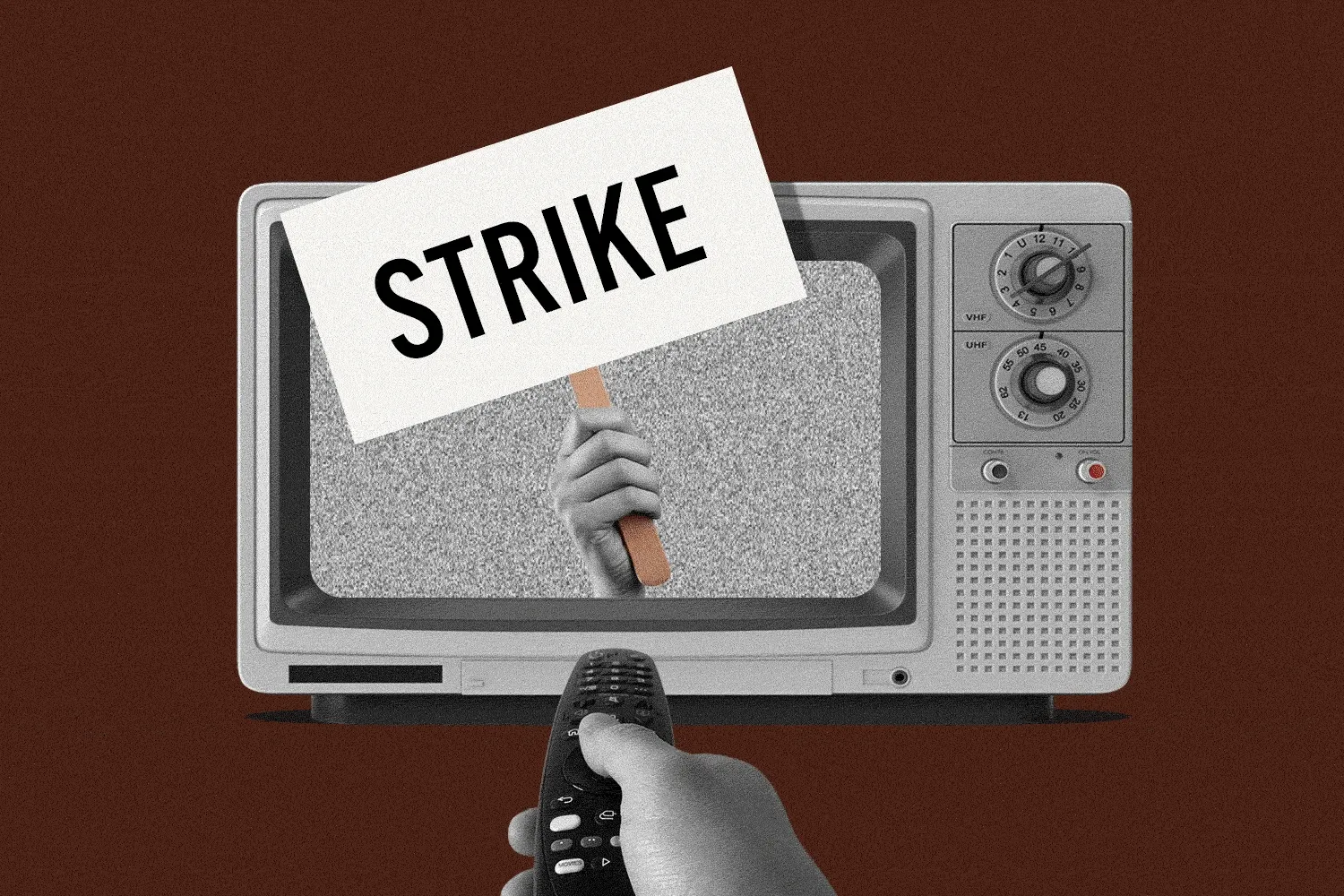As strikes halt Hollywood projects, the TV ad industry is on the line
“This could be the final nail in the live-entertainment-on-traditional-television coffin,” one media buyer said.

Francis Scialabba
• 5 min read
Wondering what’s going to be on TV in a few months? So are advertisers.
TV networks, whose scripted productions have come to a halt as nearly every actor and writer in Hollywood withholds their labor to advocate for things like better compensation and AI protections, have cobbled together fall TV schedules for advertisers to commit their dollars to—schedules that are heavy on reality TV series, game shows, and animated fare, and lighter on live-action scripted shows.
“From mid-September onwards, it’s going to become very clear to audiences that there’s a lot less content available,” Fred Black, a principal analyst at the research firm Ampere Analysis, said. “Companies were already gambling on audiences accepting less scripted content that they’ve previously been provided with, but now that number’s maybe been halved again by the strikes.”
Peak TV was already on the decline; media businesses are cutting costs to help staunch the bleeding from costly streaming endeavors. And now the strikes’ effects on the TV business have created a new industry inflection point. Advertisers, many of whom were already wary of committing ad budgets during upfronts due to economic conditions, are themselves faced with a question that has no easy answer: With scripted television production halted, will other live programming or streaming be able to make up the difference of lost television audiences, or will advertisers look elsewhere?
“This could be the final nail in the live-entertainment-on-traditional-television coffin,” one media buyer at a major agency, who spoke to Marketing Brew on the condition of anonymity to preserve client relationships, told us. “If [networks] can’t deliver new content, they lose advertising dollars—and those advertising dollars, they may never get back.”
Running low
Entertainment programming viewership has been trending downward for years, but it’s still the bread and butter of linear TV advertising.
Agencies tend to allocate around 58% of spend toward entertainment programming on behalf of brands, and around 30% to sports, according to Darrick Li, VP of sales, North America media owners, at Guideline, which tracks about 90% of the US agency market using billing data. Beyond that, new entertainment programming is often priced higher than repeat programming, delivering more revenue to media companies.
There’s some programming that’s more strike-proof than scripted, including live sports. But there are simply not enough sports broadcasts to make up for the audiences and impressions that could be lost by a dearth of new scripted shows.
“That’s going to be a difficult gap to fill in the revenues there,” Black said. “You just know that the viewership is going to suffer.”
Get marketing news you'll actually want to read
Marketing Brew informs marketing pros of the latest on brand strategy, social media, and ad tech via our weekday newsletter, virtual events, marketing conferences, and digital guides.
That suffering only stands to intensify in early 2024. “Obviously, the longer the strike, the more that could have an effect as you look into 2024 and beyond,” Comcast President Mike Cavanagh recently told investors.
Up stream
In the meantime, where can those audiences be made up? In the near term, media companies and advertisers are eyeing streaming platforms, where deep libraries can satiate audiences’ cravings for original scripted programming—for now. “It’s just a question of, ‘Can the weight equal what the losses are in terms of the millions of households typically reached in live linear television?’” the buyer told us.
Plus, audiences on streaming are generally more fragmented, and there are fewer ads, presenting a volume problem, Dave Morgan, CEO and founder of TV advertising platform Simulmedia, said. Besides that, even the biggest streamers aren’t yet on the same level as TV in terms of viewership.
Streamers will have what linear television soon won’t have: More new programming, since streamers often work far in advance and with international productions not affected by the striking unions. Still, some international productions for US streamers have been paused, causing a ripple effect through local economies, Black noted.
End of an era?
With new productions on the decline and questions about reach abounding, what’s an advertiser to do? In the immediate future, Li said he expects the scatter market to be hot if buyers hold back on upfront commitments.
Advertisers are “going to want to wait and see before they commit their dollars,” Li said, noting that scatter premiums have been at an attractive 6% or 7% in recent quarters, compared to a 20% premium price tag in the past.
For media companies’ part, Morgan said he expects them to leverage programming scarcity—and the lack of large-scale alternatives—in their favor to drive up prices if they can.
But there is a risk that ad dollars could permanently shift elsewhere, particularly toward influencers and creators, some of whom don’t aspire to be union-card-carrying Hollywood stars. “We’re going to see these high-profile and then mid-profile creators use this opportunity to fill some of these gaps, and really cement their positions,” Morgan said.
In the long term, it could also mean traditional media companies begin to behave even more like streamers—which could leave advertisers relying elsewhere for audiences they could once reliably find on prime time—perhaps even permanently.
“There’s a reason why people advertise, and if television isn’t providing that weight in-market, that money will find a way to market,” the buyer said. “That’s the existential threat to television.”
Get marketing news you'll actually want to read
Marketing Brew informs marketing pros of the latest on brand strategy, social media, and ad tech via our weekday newsletter, virtual events, marketing conferences, and digital guides.